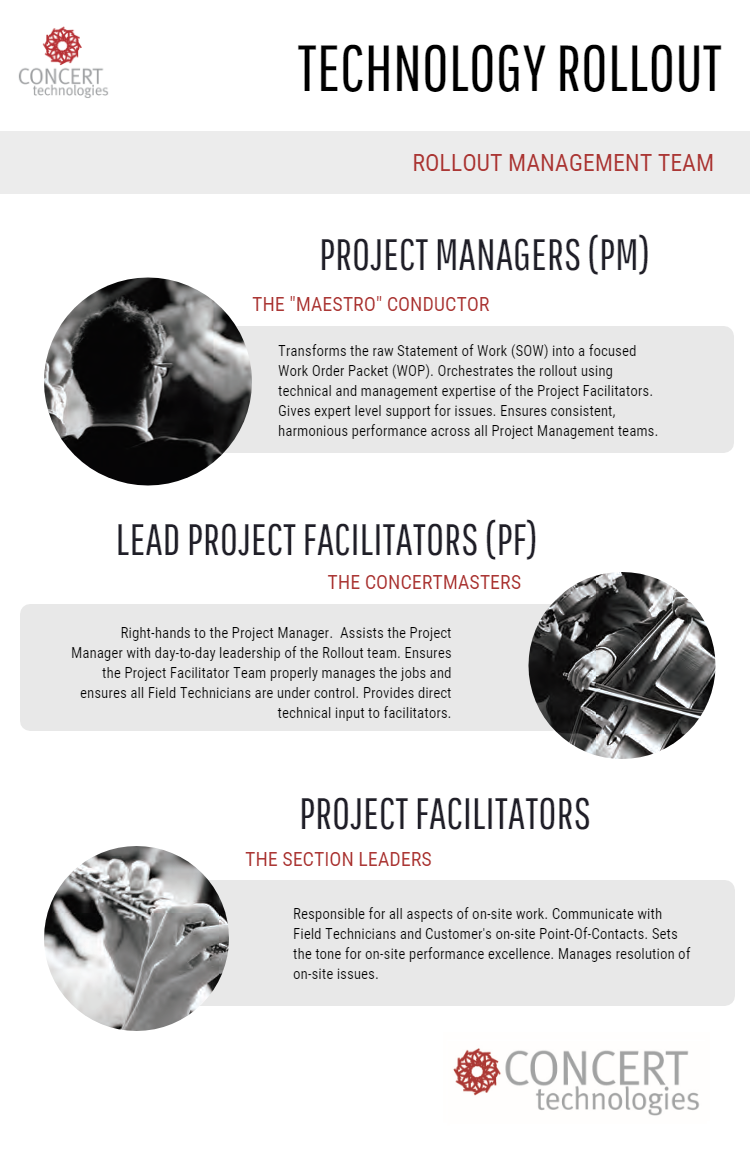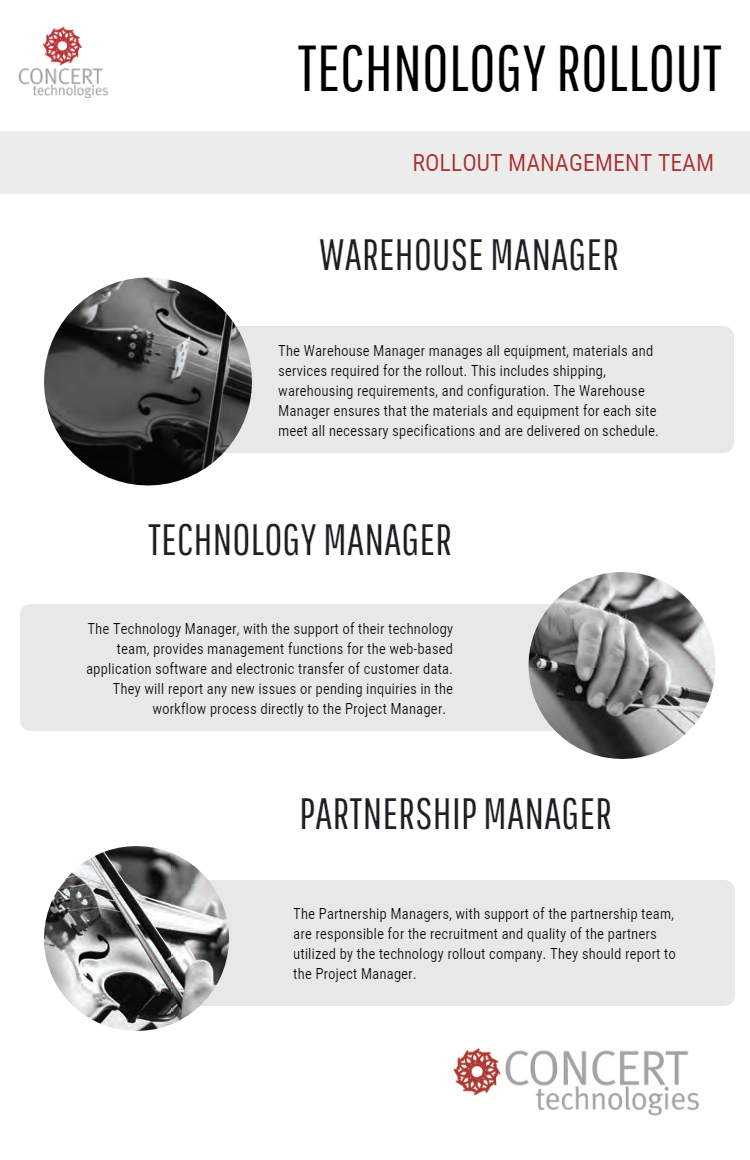Effectively managing multi-site IT infrastructure projects takes strategic perspective and a thorough understating of how large, multi-site rollouts impact internal operations. The rollout should only be limited by the skill and ability of the team that implements the rollout, never the technology.
To ensure successful implementation of IT infrastructure, an effective technology deployment must use a set of internal systems and methodologies. Establishing a scalable delivery model ensures the success of a rollout, regardless of the size of the project, or the technologies being deployed.
It is the standards and measurements of the rollout protocols that ultimately determine the level of quality and consistency of the team’s delivery. Once the necessary IT infrastructure framework and systems are in place, a rollout delivery team can be organized and trained.
Configuring a Successful Rollout Delivery Team
The Configuration of a rollout delivery team can be broken down into six major categories: Project Managers, Lead Project Facilitators, Project Facilitators, Warehouse Managers, Technology Managers, and Partnership Managers.
Together, these team members oversee all aspects of the rollout and ensure it is completed to the highest quality: on time and on budget.
Project Manager
A successful nationwide, multi-site technology rollout begins with a realistic statement of work and ends with an achievable schedule. It is the Project Manager who is responsible for ensuring that the rollout is completed to the customer’s specification, and that a consistent level of expertise and speed is achieved. The Project Manager serves as the customer’s single point of contact for the rollout.
Lead Project Facilitator
From interaction with the client, to management of the Project Facilitators, the Lead Project Facilitator manages day to day aspects of the rollout. This position has the necessary support of Project Facilitators, warehouse personnel, and technology staff to provide rollout services.
Project Facilitator
Project Facilitators manage all aspects of the local site resources, including: scheduling, onsite job performance assurance, communication with the local site point of contact, and interfacing with materials management. They manage the on-site technicians and are responsible for prompt and accurate site updates. There are multiple Project Facilitators in the team, and they report to the Project Manager.

Warehouse Manager
The Warehouse Manager manages all equipment, materials and services required for the rollout. This includes shipping, warehousing requirements, and configuration. The Warehouse Manager ensures that the materials and equipment for each site meet all necessary specifications and are delivered on schedule.
Technology Manager
The Technology Manager, with the support of their team, provides management functions for the web-based rollout application software and electronic transfer of customer data. They report new issues and pending inquiries on the workflow process directly to the Project Manager.
Partnership Manager
The Partnership Manager, with support of their team, is responsible for the recruitment and quality of the partners utilized by the technology rollout company. The utilization and management of vetted partners guarantees that the on-site rollout service delivery is performed to the required standard. The Partnership Manager guarantees the quality and redundancy of all partnerships utilized by the technology rollout company. They should report to the Project Manager.

Understanding how each group works together within the Technology Rollout Team, is the first step to developing a team that ensures a successful rollout. However, to overcome the unique challenges presented by large scale rollouts, each group must clearly understand and address their responsibilities. A unified technology rollout delivery team is able to optimize their flexibility and successfully scale each project, while providing outstanding quality assurance.
Here are the 5 Steps to developing the proper internal systems and methodologies to successfully scale multi-site, multi-technology rollouts:
Understanding Personal Workload Thresholds
Properly increasing the headcount of project managers, facilitators and partners to complete a large-scale rollout, means understanding the limitations of your team members. Does the team have the necessary resources available, or do new managers, facilitators and partners need to be hired and trained?
Developing Training Programs
When new personnel are needed to achieve the rollout team’s goals, it is important to have efficient, certified training programs in place. Adequate training in the internal system processes and methodologies is vital to giving the team the best chance of success.
Determining Partner Run Rates
Increasing the size of the project and the job volume inevitably impacts the team’s ability to complete a project. Accurately tracking the daily, weekly, and monthly run rates of each partner used helps to assess the team’s ability to manage and complete each job of the rollout. The Partnership team must do their due diligence when selecting who to bring on, but it is the Project Facilitator and Project Manager that sees each job through to completion.
Optimizing Communication Flow
To meet customer specifications, it is important to have effective communication channels between the client and the project manager, as well as between all members of the technology rollout team – both on and off site. The utilization of a full-function online project management tool, increases communication efficiency by providing real-time updates to team members. The technology rollout company should develop and optimize an operational software to handle rollouts of all sizes. Each team member must be trained to have a thorough understanding of the software, and their daily tasks and responsibilities within the platform.
Ensuring Quality Assurance
The utilization and management of multiple project managers, facilitators, and partners ensures that every part of the rollout is properly deployed. Redundancy allows the team to overcome issues which arise, such as: sick-leave, vacation, injury, personal emergency, and termination. Hiring multiple managers and team members, safeguards against any internal issues throughout the rollout delivery.
Internal System Processes and Methodologies Ensure Success.
IT infrastructure is constantly evolving and new technologies bring new challenges for rollout teams. When providing effective business solutions by updating existing infrastructure, the success of the project should not be dependent on what technologies are to be implemented.
An expert rollout team follows a defined methodology, with processes outlined and followed from day one of the project. Using a scalable model, which includes everything from pre-job workup to communication management software and project documentation, ensures a successful delivery for every size and type of technology rollout.





